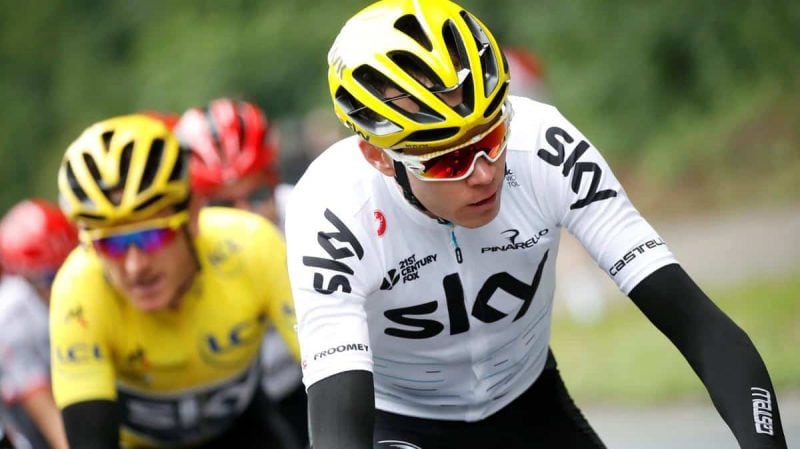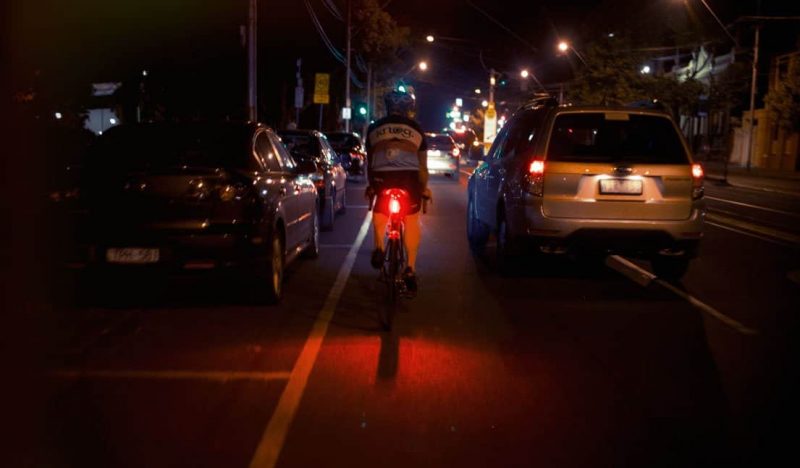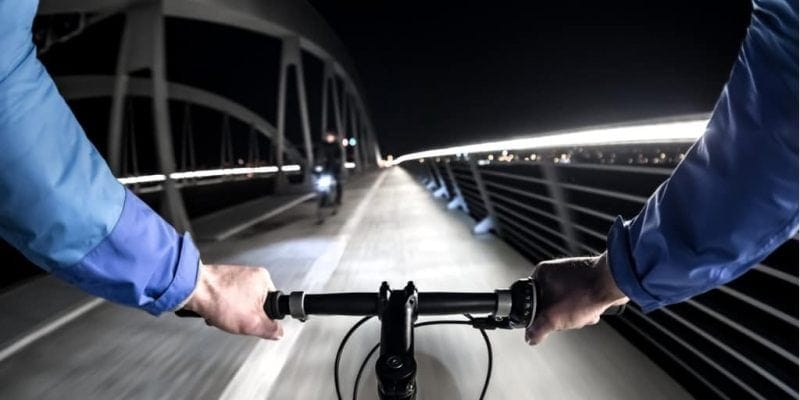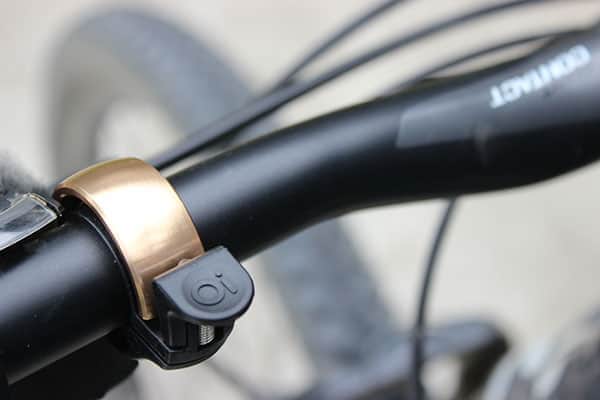Tips -
How You Can Avoid Getting Hit By Cars While Cycling
Did you know:
Recent bike safety statistics showed that 818 cyclists were killed on U.S. roads in 2015.
That’s 2.24 people per day! (Source: NHTSA)
If you dig deeper into that report, you’ll find that figure represents 2.3% of all traffic fatalities. Simultaneously, cycling ONLY makes up less than 1% of all trips taken in the U.S.
Further to that, an estimated 45,000 cyclists were reported to be injured on the road. The actual is much higher as we all know that many cases were unreported.
Cycling safety has become one of the major concerns on the road in most countries around the world. It’s because there has been a significant increase in the number of disastrous road accidents and crashes involving cyclists.
There’s a high possibility cyclist could get hit while riding their bikes every day.
The local conditions determine the causes of crashes, and it also varies accordingly.
It can be caused by speed, weather, rider visibility, brakes, road condition, automobile and bicycle traffic, distracted driving, driving, and riding under the influence.
Read More : 35 Tips to Stay Safe on the Road
Now that you know, you are afraid and probably saying, “I think I am going to stop cycling.”
Do you think that is the solution?
No! You don’t need to stop.
Read on…
Here are 11 common ways cyclists get hit and how you can avoid it.
1. Being Rear Ended
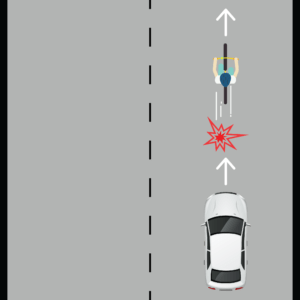
This is a situation where you are riding along the road with the traffic flow, or you innocently ride a little to the left to go around an obstruction such as a parked car and a vehicle runs directly into you from the rear.
Most cyclists fear this the most when they’re out riding but did you know that this makes up only 3.8% of all cyclist collisions?
What Causes You to Be Rear Ended
- Lack of visibility. When the driver couldn’t see you in front, this situation can occur. The common ones are dark clothing, the absence of bright rear bike lights, or the sun shining directly into the driver’s eyes.
- Lapses in concentration or recklessness by the driver. When the driver is being distracted or when the driver is drunk, thereby driving carelessly, it can lead to a situation like this.
How to Avoid Being Rear Ended
- Use tail lights during the day AND night. Set it on blinking as they tend to attract more attention. When the rear light blinks, a vehicle coming from a distance will know something is in front, and the driver would slow down and avoid running into you. A good and value for money tail light is the Cygolite Hotshot 100.
- Wear high visibility cycling clothing. Don’t wear dark clothing just because it’s your favorite color. Wear bright cycling clothing or a reflective cycling vest if you’re riding in the dark.
- Ride on wider roads. Ensure you ride on roads having wide outside lanes that can fit a bike and a vehicle side by side. This gives vehicles enough space to pass you without hitting you.
- Use a rear mirror. You can see the driver coming behind. Alternatively, you can invest in a tail light with a built-in radar, such as the Garmin Varia Radar. When paired with a Garmin bike computer, it will show you vehicles approaching you as far as 140 meters away.
- Don’t rely on only rear reflectors. The reflectors should complement and not replace your tail lights.
- Avoid freeways. You don’t want to have vehicles zooming past you at high speeds.
- Don’t hug the curbs. While this may sound counter-intuitive, riding about 2 feet off the curbs gives you some room to maneuver should a vehicle come too close.
2. The SMIDSY

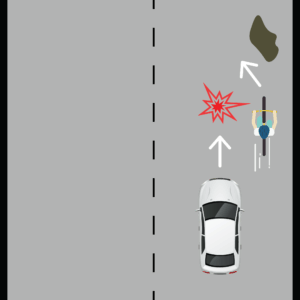
A situation where you decided to change your riding line abruptly due to obstacles in front and the car behind clipped you.
What Causes the SMIDSY Accident
- Avoiding obstacles. You saw an obstacle in front of you. It can be a parked car, traffic cone, potholes, uneven surfaces, sharps, and much more, and you moved left and outwards to avoid it. This might catch the driver unaware thereby hitting you by accident.
- Moving out from parking lots. You’re riding along empty parking lots and there is a car parked in front and you need to move left, outwards.
- Merging lanes. The lane you’re riding in ends and it merges into one.
How to Avoid the SMIDSY Accident
- Slow down, look back, and left before moving outwards. You shouldn’t be in a hurry to move outwards; there might be a vehicle coming behind and trying to overtake you.
- Use hand signals. Remember, don’t rely on your tail lights alone. Make use of your hand to signal to the vehicle coming behind you. Make sure you signal for 4-5 seconds before making your move out.
- Use a rear mirror that you can mount at the end of your handlebars. This will ensure you see the oncoming vehicle before moving outwards. Also, you will be able to see if the road is clear for you to change lanes or not.
- Don’t swerve in and out between parking lots. Stay on your current riding lane to avoid having to swerve out again. You never know. You might be confusing the vehicles coming behind you. Also, don’t think you own the lane if there are 10 empty parking spots because when the packing lane ends, you will need to merge into the traffic, and no driver might be expecting this.
- Avoid sudden movements. Look further ahead and always scan your surroundings to avoid having to react to potholes at the very last minute.
3. The Right Hook
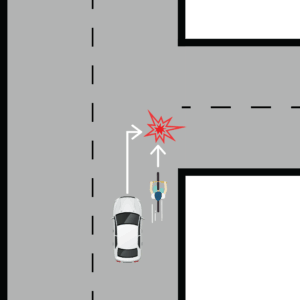
The Right Hook is one of the prevalent situations where cyclists get hit at intersections.
This situation happens when a car makes a right turn in front of you or runs directly into you. The driver might be thinking he would out-speed you because he thinks you are riding a bike and can’t ride faster.
Did you that 89% of cyclists killed or severely injured in New York City happened at intersections?
And 21% of cycling fatalities happened due to vehicles turning?
What Causes the Right Hook
- Misjudged speeds. You’re riding near the curbs and approaching a right turn junction. But you plan to head straight. A vehicle comes up from your back and makes a right turn in front of you. The car misjudged your speed thinking it has enough time to pass you completely before making the right turn.
How to Avoid the Right Hook
- Ride further to your left or the middle of the lane when approaching a right junction if you’re planning to head straight. By doing so, you minimize the chance a vehicle would come up from behind and make an abrupt right turn in front of you.
- Look in the rear mirror. Even if you’re going straight, have a quick look to see if any cars are approaching and if their indicators are turned on.
4. The Other Right Hook
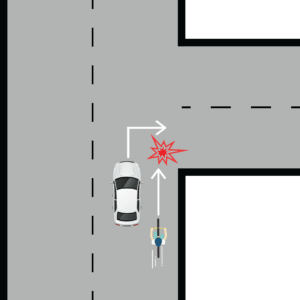
This is a situation where you are riding on the right side next to a slow-moving vehicle, and then it unexpectedly makes a right turn into you. The driver might be trying to enter the driveway, side street, or parking lot.
What Causes the Other Right Hook
- You’re in their blind spot. The driver can’t see you in their rear mirrors.
- The driver is not concentrating on the road. The driver is driving slowly as he is on the lookout for something by the roadside. Hence he didn’t see you.
How to Avoid the Other Right Hook
- Keep a distance. Keep a safe distance (e.g., 10 feet) behind a slow-moving car in built-up areas. Stay alert and be prepared to react in case they make an abrupt right turn.
- Don’t ride in the driver’s blind spot. The driver can’t see you if you position yourself there.
5. The Red Lights of Death
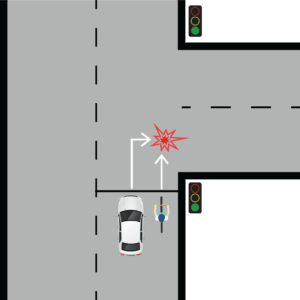
This situation occurs where you stop at the right side of a vehicle that has already stopped at the red lights.
Because you stopped on their right-hand side, the driver might not be able to see you. So when the green light comes up, you move forward while the vehicle turns right and into you.
What Causes the Red Lights of Death
- You’re not visible. You stopped beside or in the car’s blind spot. When the lights turn green, the vehicle makes an unexpected right turn and into you. The larger the vehicle, the higher the possibility of the driver not seeing you.
- Lack of patience. You are waiting for the green light to show, and so is the vehicle beside you. When the lights turn green, you are in a hurry to move forward, trying to outsprint the vehicle. Do you know what direction the vehicle beside you is going? If it’s turning right, you are on their right side. It might run into you.
How to Avoid the Red Lights of Death
- Stop in front of the vehicle. Doing so would make you visible to the driver. Ride straight ahead when the lights turn green. Also, make sure that there aren’t any vehicles running the red lights.
- Stop behind the vehicle. Make sure you stop directly behind and not at their blind spot. Doing so would make you visible when the driver checks his rear mirror. Let the vehicle go first when the lights turn green. Let the vehicle go first when the lights turn green. Don’t try to overtake. You can’t tell if it will turn right or not.
- Check for indicator lights. While you’re stopped, check if the vehicle is indicating where it wants to go.
6. The Wrong Way Wrecker
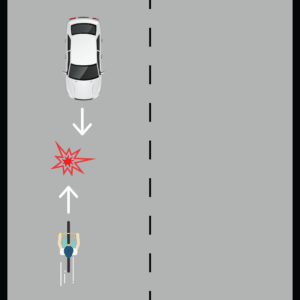
You are cycling on the side of the road or sidewalk against the traffic flow. While this might sound against our basic common sense, it’s still a common occurrence, especially among kids and around built-up areas.
Did you know: Riding in the wrong way is 3 times more dangerous? For children, the risk is 7 times greater.
The driver does not expect you to ride your bike against the flow of traffic. This puts you in a dangerous situation like a head-on collision crash or side hit crash if the vehicle driver turns without seeing you.
Riding against traffic is the most dangerous decision you can make as a cyclist.
Even though you might think it is safer because you will see the vehicle coming in front of your front, you would be confusing the vehicle driver. He will have less chance to know your speed and distance.
Avoid this at all costs. Period.
Let’s assume that you’re riding at 15mph against an oncoming car traveling at 40mph.
Your relative speed to the car is 55mph (15 + 40), and this gives the driver a much lesser time to react compared to you riding with the traffic flow (40 – 15 = 25mph).
What Causes the Wrong Way Wrecker
- You’re riding in the wrong way. The oncoming car doesn’t expect to see you there and runs into you head-on.
How to Avoid the Wrong Way Wrecker
- Ride with the traffic flow. It’s as simple as that. While you may think that riding against the traffic would make you more visible, it’s actually not. Drivers don’t expect you to be there. Hence, they don’t concentrate on that, especially when turning out from the parking lot or driveway.
7. The Sidewalk Havoc
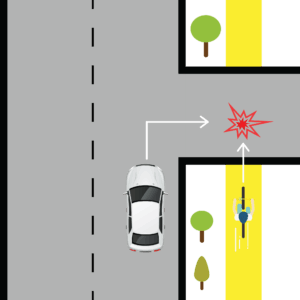
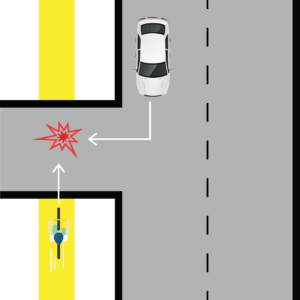
Riding along sidewalks can be dangerous, especially if the sidewalk has furniture such as signboards, seating, trees, bins, etc. along it. This furniture actually limits the driver’s visibility, and they might run into you when they’re turning.
In some parts of the US, like San Francisco, Ohio, Columbus, and New York City, any cyclist older than 13 cannot ride a bicycle on the sidewalk. But this rule does not apply everywhere like Washington, D.C, and Boston.
Many studies like Wachtel & Lewiston 1994 and Aultman-Hall & Adams 1998 have shown that riding on the sidewalk has a higher risk of crashing than depending on the road.
If you’ve no choice but to ride on sidewalks, have a bike bell so that you can alert the pedestrians.
What Causes the Sidewalk Havoc
- You’re not visible. The driver didn’t see you riding on the sidewalk, makes a turn, and runs into you.
How to Avoid the Sidewalk Havoc
- Use a headlight to make you visible to the oncoming vehicle. You should be using a headlight even during the day as almost 50% of cycling fatalities in the U.S. occurred during the day. Set it to flash or strobe mode to attract attention. It’d be better if the headlight as side lightings such as the Light and Motion Urban 900.
- Use a tail light. A tail light would make you visible and alert any drivers approaching the sidewalk and intending to turn into it.
- Look side and back. Always look to your side and back before crossing between sidewalks between streets.
- Don’t ride on sidewalks. The best way to prevent this situation from happening is to avoid riding along sidewalks. Riding on sidewalks makes you vulnerable to vehicles pulling out from driveways and you’re also a threat to the pedestrians. In December 2002, Keith Vick died from this situation.
8. The Door Prize
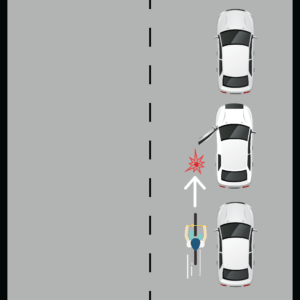
This is probably the number one nightmare for most cyclists. It’s also the third most common bicycle and vehicle collision in Toronto.
In the Netherlands, the children are taught about the Dutch Reach, a technique to open the vehicle’s door using the hand furthest from the handle.
In the U.S., it means opening the driver’s car door with your right hand instead of your left. Try it the next time you drive.
If you are riding in an area where people park cars on one side of the street, there is a high probability that one of the doors get opened anytime. So you should be careful.
What Causes the Door Prize
- The driver opened the car door without looking. This could happen due to several reasons. It can be due to bad habits or pure negligence.
How to Avoid the Door Prize
- Ride further to the left of the vehicle. Leave a gap of 3 feet, or 4 if possible when you’re passing parked vehicles. This ensures that if the driver does open the door unexpectedly in front of you, there is a gap between the door and you.
- Use a headlight to attract the driver’s attention before the open the door. Your headlight’s beam (set if on flash or strobe) will be seen through their side mirrors.
- Slow down and look through the rear window of the vehicle to see if anyone is in there. If there is, move a little to the left in the case they do open the door.
9. The Right Cross
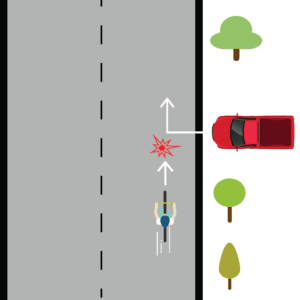
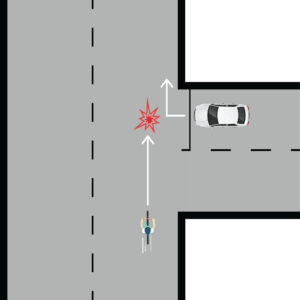
You’re riding straight ahead, and a vehicle pulls out from a street, driveway, or parking lot on your right.
The vehicle could either run into you or miss you by a split second. This is one of the most common ways you can get hit as a cyclist.
There could be 2 possible scenarios here. The car can hit you while coming out of another street, or you can slam into the car if it comes out in front of you.
What Causes the Right Cross
- You’re not visible. The driver didn’t see you when they’re pulling out.
How to Avoid the Right Cross
- Use a headlight to attract attention during day time. Set it on flash or strobe mode. If you’re riding in the dark, you MUST use a headlight as mandated by the law. I’d say at least 600 lumens for riding in the dark, or something similar to the Knog PWR Rider headlight.
- Slow down and look to your right. Whenever you’re approaching a junction, don’t just look ahead. Slow down, look to your right and prepare to stop if vehicles are coming on your request unexpectedly. Make eye contact with the driver if you can so that they know you’re passing through. In case you can’t make eye contact with the drive, make use of your hand by waving it.
- Don’t ride too near to the curbs. By riding very near to the curbs, you’re indirectly indicating to the car that you intend to turn right when you actually want to ride straight ahead.
10. The Left Cross
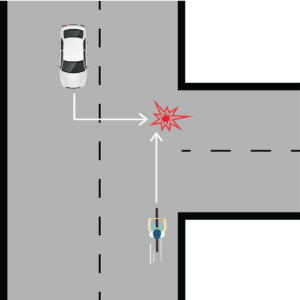
This is similar to The Right Cross. The only difference is that the vehicle is coming from the opposite direction and makes a left turn into you at the intersection.
This situation has happened to the Austin Cycling Association, John Howell, and some other Austin Cyclists such as Janne Osborne and Dr. Lee Chilton.
What Causes the Left Cross
- You’re not visible. The driver didn’t see you approaching from the opposite side, or they underestimated your speed into the intersection.
How to Avoid the Left Cross
- Use a headlight. Make yourself visible, both during the day and night. It’s mandated by the law that you should use road bike headlights at night.
- Wear visible clothing. Choose clothing that is light in color. Alternatively, wear a reflective cycling jacket over your dark dress.
- Slow down and prepare to stop if needed, even if you might have the right of way.
- Don’t ride on sidewalks. Depending on the sidewalks in this situation brings two risks. First, the driver wouldn’t see you clearly. Secondly, if they see you, they expect you to stop and give way to them because you’re not on the street.
11. The Roundabout Confusion
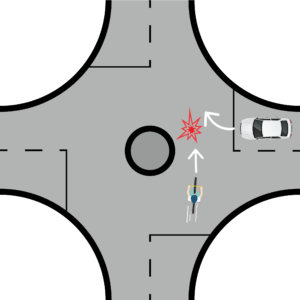
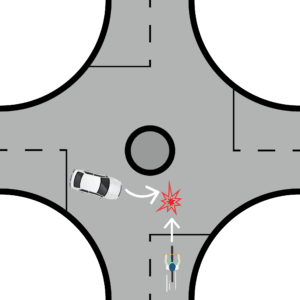
Roundabouts are always a tricky and complicated situation, especially when determining who has the right of way.
The areas in front of the road joining the roundabouts are the danger zone for cyclists.
What Causes the Roundabout Confusion
- You’re not clearly visible. The driver didn’t see you when they’re entering the roundabout.
- Misjudged speed. Both you and the driver misjudged your own speeds approaching the roundabout. Each of you thought that you’d enter the roundabout first. The worst thing that could happen is both of you ended up joining the roundabout at the same time.
How to Avoid the Roundabout Confusion
- Use a headlight both during the day and night. The headlight will attract the driver’s attention on your right and indicate to them you’re in the roundabout and they shouldn’t enter it.
- Slow down and prepare to stop. It’s a good habit always to do this when approaching a roundabout.
- Stay away from the edge of the roundabout. Take your lane at the center of the traffic lane. That is where drivers will be paying more attention.
- Don’t enter the roundabout if there are vehicles on your left. Always look to your left and only enter the roundabout if there are no oncoming vehicles.

